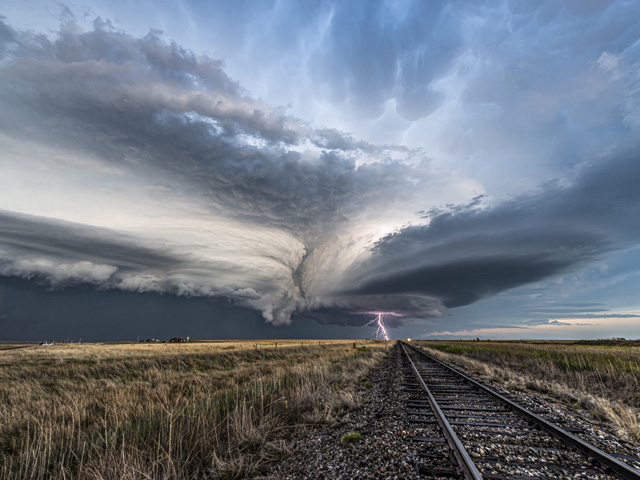Ag Weather Forum
Strong Fall Storm Hitting Plains and into Canada This Weekend
A strong storm system will move through the Rockies on Saturday, exit into the Plains on Sunday, and then move from the eastern Dakotas to Hudson Bay in Canada on Monday. Strong winds, areas of showers and strong to severe thunderstorms, and accumulating snow are all on the table.
The Plains will take the brunt of the storm, but impacts will be felt throughout much of the country.
This system is on the leading edge of a pattern change that is coming to North America. An upper-level ridge in the western half of the continent and a trough in the eastern half is going to completely flip this weekend and last through next week.
You can read more about the process for why that is happening here: https://www.dtnpf.com/….
With the pattern flip, it will get much more active. The trough moving into the western states starts Friday, bringing scattered showers to the Pacific Northwest and Montana, an area that has seen drought growing in recent months. On Saturday, showers will increase across the Intermountain area. We should see valley rains and mountain snows, but the snow may also start to develop over portions of the Montana plains.
INCREASING WINDS
While the system builds in the West, winds will increase across the Plains. Though not entirely strong on Saturday as winds gust in the 25 to 35 mph range, perhaps a bit stronger from Oklahoma into Texas, winds will really ramp up on Sunday.
P[L1] D[0x0] M[300x250] OOP[F] ADUNIT[] T[]
There is some uncertainty tied to how strong winds will get and where exactly they will occur, but from Nebraska south to Texas, models indicate gusts are likely to exceed 50 mph. Across Kansas and eastern Colorado, gusts may exceed 60 mph. With the expansive drought, very dry and in some places bare soils due to fall tillage, blowing dust will be likely.
Newly planted or emerged wheat fields may possibly be coated in a new layer of dust and eroded soil, as well as be wind-whipped. Farther north, the winds may not be as strong as farther south, but gusts in the 35-45 mph range do look likely for the Northern Plains. The winds will also increase the fire risks up-and-down the entire region.
The main low-pressure center is forecast to emerge in northeastern Colorado Sunday afternoon or evening, quickly developing and heading northeast overnight. The low will push a cold front through the Central and Southern Plains Sunday night and Monday. While background winds will eventually calm down overnight, the front is expected to trigger chances for a broken line of showers and thunderstorms from the Minnesota-South Dakota border down to central Oklahoma, curling back into west Texas.
STRONG TO SEVERE STORMS
The Storm Prediction Center has outlined an area from northeast Kansas into southern Minnesota as the most likely area to find strong or severe thunderstorms Sunday night into Monday morning. While having a low probability of becoming severe as of early Friday, there is a chance that the Center expands its outlook area and intensity probabilities. With strong winds above the surface and cold air moving in behind the front, hail and damaging winds are the primary threats.
Along with the severe threat, heavy rain will also be possible. Initially, that will not be the case. But as the front continues across Texas and Oklahoma on Monday, the storm will ingest the dying remnants of Hurricane Roslyn, which is set to make landfall on the Pacific Coast of Mexico on Sunday.
Tropical remnants being sucked into a strong cold front are a good recipe for producing heavy rain. Timing is everything though and if the remnant low is too far ahead of the front, or slows down, the heavy rain may not occur. Models have been forcing the two together more advantageously in recent runs and now rainfall of 1-2 inches is forecast from central and Eastern Texas up through Missouri on Monday, perhaps repeating a severe threat and then moving eastward through the Midwest and Southeast on Tuesday.
As the system curls up in the Northern Plains on Sunday, precipitation will expand and wrap around the low center, extending north into Canada. Cold air will fill in behind the storm. Being as incredibly dynamic as fall systems can be, the cold air will turn some of the precipitation over into snow.
ACCUMULATING SNOW
Accumulating snow will be possible for Montana, Wyoming, and the western Dakotas north through the Canadian Prairies. Amounts are tough to say as some areas of cold and precipitation will not overlap, but a couple of inches will be possible outside of the higher terrain. In the Canadian Prairies and some spotty areas in Montana and the Dakotas, amounts up to about 6 inches will be possible. For late October, that is not out of the ordinary, but would be the first substantial snowfall for the Plains this season.
The system forming in the West will be the start of a more active pattern for the next two weeks. Additional storm systems may not be this strong, but we should expect more fall-like swings in temperatures and periods of precipitation to move through. One area that is not forecast to see much precipitation is the southwestern Plains. The front to this system will largely skip over eastern Colorado, most of Nebraska, western Kansas, and the Oklahoma and Texas Panhandles. Along with the blowing dust issues, winds should continue to pull moisture out of the soils, degrading the drought where the rains miss.
To find more regional weather conditions and your local forecast from DTN, head over to https://www.dtnpf.com/…
John Baranick can be reached at john.baranick@dtn.com
(c) Copyright 2022 DTN, LLC. All rights reserved.




